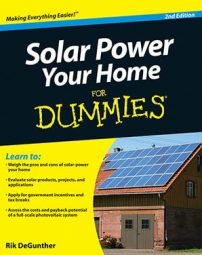When you switch to solar power for your home, mounting your photovoltaic (PV) solar panels is of critical importance. First, you need to mount the panels where they'll get maximum sunshine over the course of a year. But the more difficult problem is mounting them with enough integrity that they'll stay put for 25 years or more.
PV modules are temperature sensitive. When the weather gets hot, power output goes down. Systems often output more power on a cold, clear spring day than on a hot, muggy summer day, despite the fact that there's a lot more sunshine on a summer day. Because the modules are temperature sensitive, you need to pay attention to how they're mounted.
Roof-mounted systems
Roof mount PV is by far the most common and comprises around 95 percent of all residential PV systems. Mounting panels onto your roof is the least expensive way to install solar panels. It also raises the panels above ground level so that shade issues, like trees and neighbor's houses, are minimized. Four types of mounting systems are in common use:
Rack mount: The PV panels are captured by a metal framework specially designed to allow easy attachment and detachment of the panels. The panels are almost always parallel to the roof surface. A wide range of different types of racks are available. In many cases, a particular panel manufacturer will also provide the rack mount specifically for their panels.
Stand-off mount: The panels are supported by a frame built above the roof. Unlike the standard rack mount, the angles can be adjusted so that the panels aren't parallel to the roof plane. Stand-off mounts are ugly, but if you don't care about the visual appearance, you can get better production. These types of mounts are generally used for homes that have way too much shade on the southern roof exposure and a sunny northern exposure.
Direct mount: The panels are attached directly to the roof. There is no air gap between the roof and the panels, so there is no cooling. Although you save money on the cost of the rack equipment, your system production suffers.
Integrated mount: PV panels replace conventional roofing materials and attach directly to the roof's rafters. These are sometimes referred to as BIPV, or Building Integrated PV. You save on the cost of roofing materials, and the visual appearance is nice. If you're retrofitting an existing building, it's not worth it to use integrated mount because of the cost and waste of removing the existing roofing materials and throwing them away. However, if you're building a new home, BIPV may be the best option.
Ground-mounted systems
If you have enough space available, you can mount your panels in a specially engineered rack structure affixed to the ground. In other cases, roofs are simply too complex, with too many vents and odd angles, to support a large array of solar panels, so ground mount may be the only option.
Ground-mounted systems offer both pros and cons: On the pro side, you can orient the panels directly south, at the optimum tilt angle. This ensures the maximum amount of production over the course of a year. You also won't have to worry about leaks in your roof, and the panels are easier to maintain and change, if the need arises.
On the negative side, ground-mounted systems are more expensive than roof-mount because they require concrete posts and rigid frames. Wind is also more of a problem with ground mount. Ground mount systems require suitable land space, and they look industrial. You'll be putting a big, ugly, visible array somewhere on your property.

